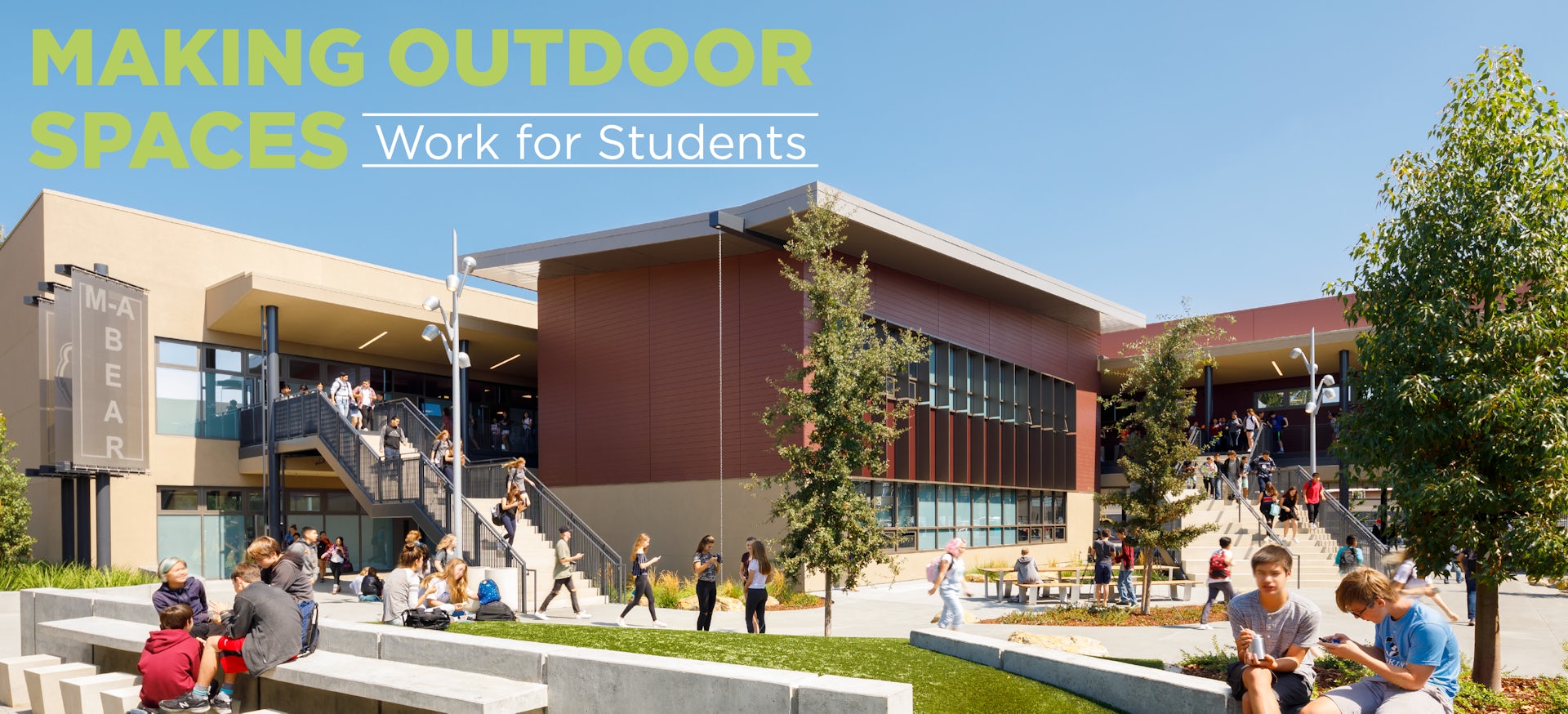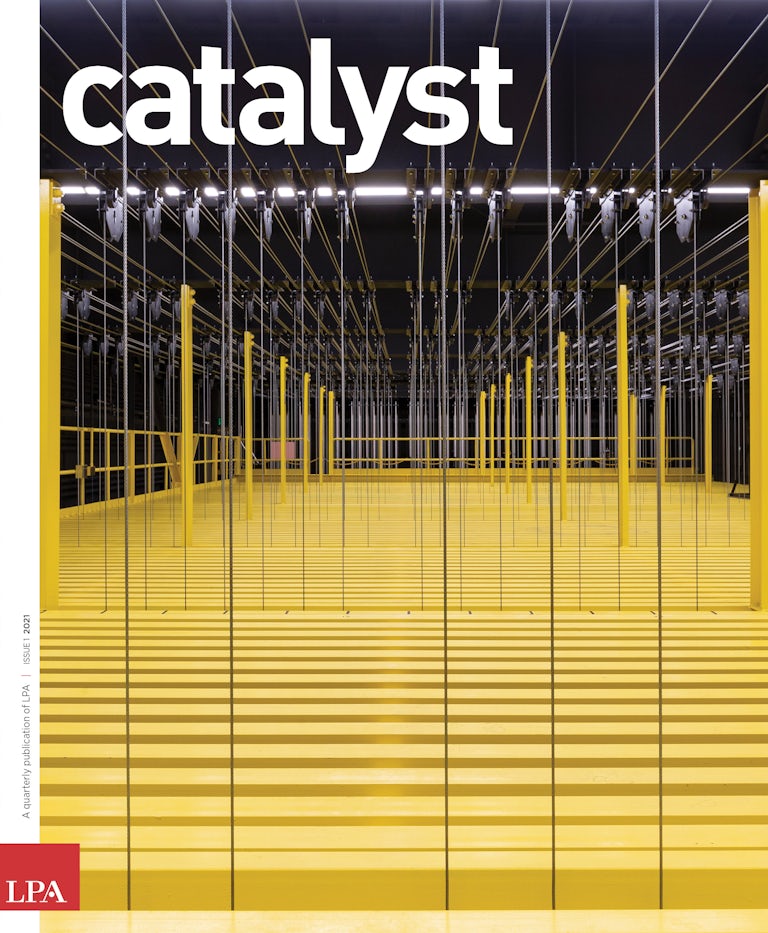Safety and health concerns during the coronavirus pandemic have highlighted the value of outdoor environments, but recent events are simply an acceleration of the movement on K-12 campuses around the country. Recognition of nature’s value in the learning process is recasting playgrounds, schoolyards, fields—even hardcourts—as new arenas for education.
Research shows that creating a strong connection between indoors and outdoors benefits students in many ways, including intrinsic motivation, cognitive function and self-esteem. Outdoor space provides children the opportunity to “narrate their own learning” and dramatically improves brain development in young students.
Making Outdoor Spaces Work for Students
Classrooms don’t have to be indoors to be effective or inspiring. The pandemic is putting the spotlight on the need to create more flexible and effective outdoor learning environments.
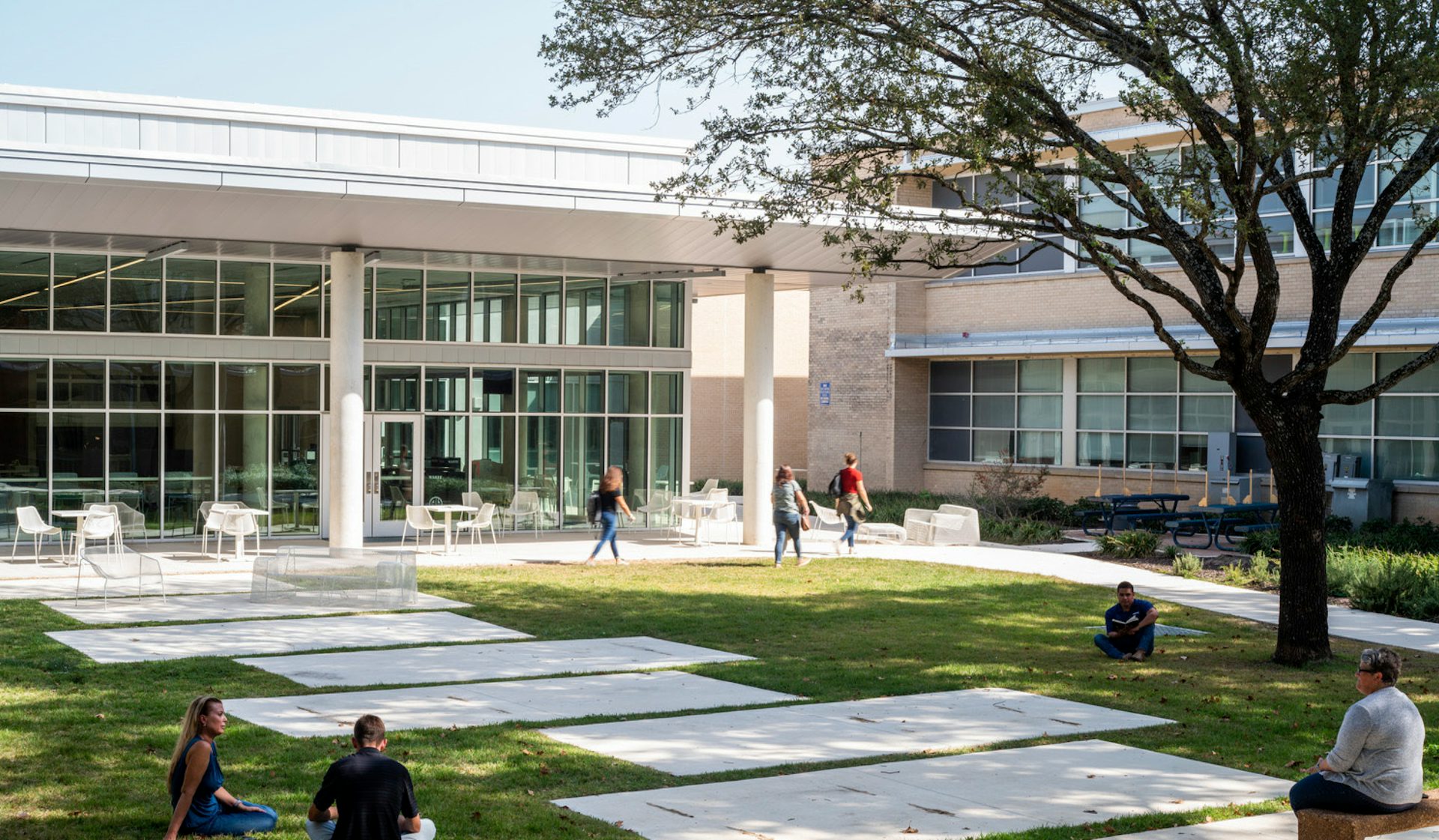
“We’re already seeing how this moment is helping schools understand how to utilize outdoor spaces in a better way,” says Kari Kikuta, LPA Director of Landscape Architecture.
Pandemic-related social distancing requirements have led to on-the-spot rethinking of how outdoor spaces function, says LPA Project Designer Lancelot Hunter. To activate outdoor learning spaces, school leaders and designers are partitioning landscaping in ways that allow for small group gatherings, creating more varied terrain for different activities and introducing new seating and layouts conducive to both meetings and relaxation.
“We can’t say that once kids leave the classroom, learning stops,” Hunter adds. “Kids learn everywhere, and the entire campus should be viewed as a collaborative environment.”
For Alamo Heights High School outside San Antonio, Texas, a central “passive” park in the middle of a dense site helps transform a compact, landlocked school. The design connects the historic buildings with flexible respite spaces, outdoor dining areas and walking paths. In addition to shaded spots for students, a variety of open spaces are available for events and educational activities.
“The openness of it is intentional; it’s like a learning park,” says Richard Bienvenu, LPA Director of Landscape Architecture. “It’s about investing in the future of what this campus will become, with green space and connection to the outdoors.”
Different school types can expand outdoor learning environments in different ways. Hunter is working on the redesign of Washington Elementary School in Santa Ana, California, which is situated on a large, multi-acre site. LPA landscape architects were involved from the start of the design process, creating the opportunity to shape the outdoor spaces, including circular planters, multi-tier seating, stages and lounge-like areas.
“The design is centered around the idea of inquisitive learning,” Hunter says. “Pupils will be empowered to learn and teach themselves with these spaces.”
As educators and designers explore the challenges ahead, they are evaluating spaces that might not previously have been considered for learning.

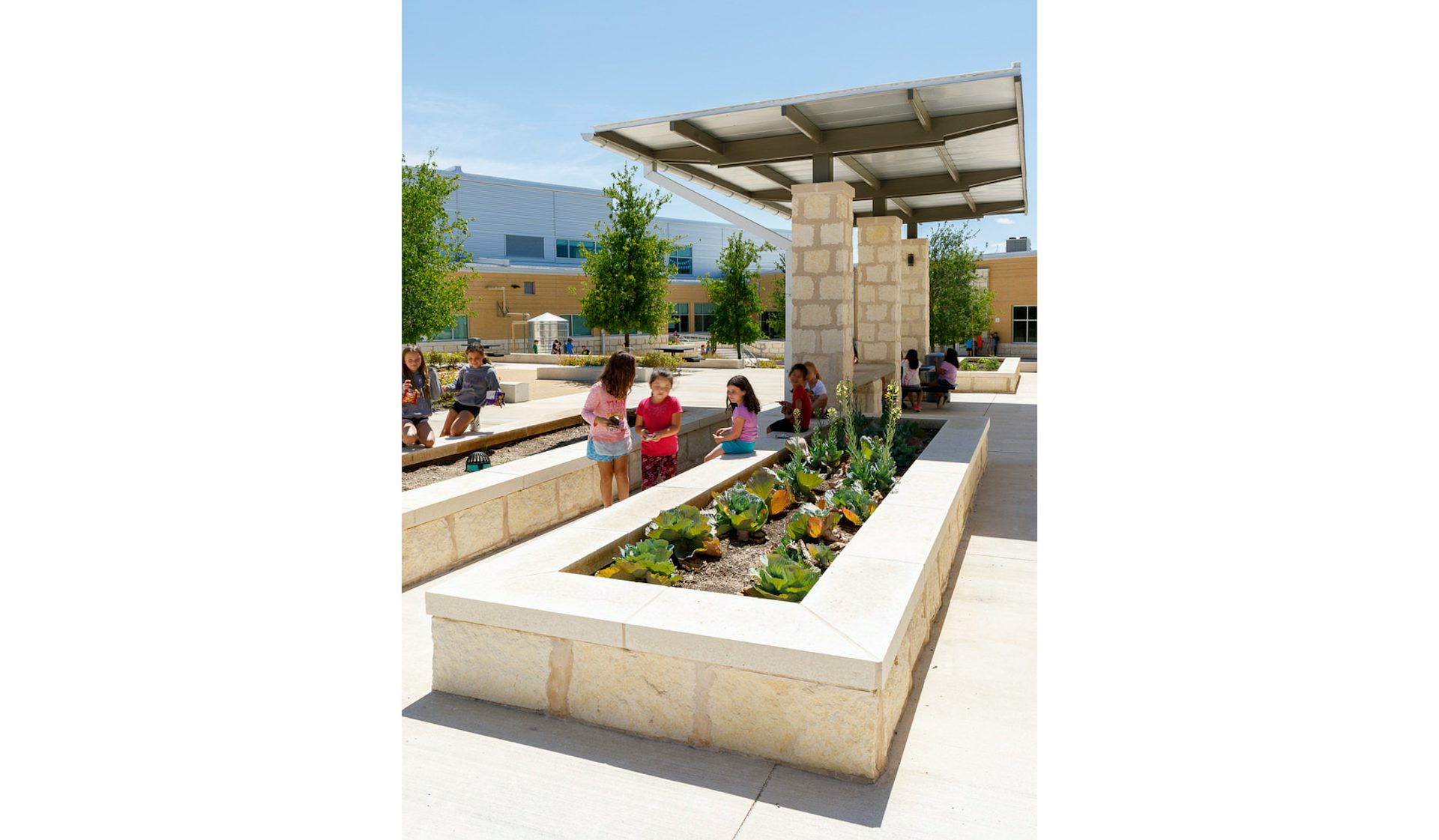

Can seating, such as log stools or cushions, be added to turn part of a playground into an area conducive to reading and writing? Are there enough exterior-friendly learning materials, work surfaces and shade elements to make it easy to leave the comforts of the classroom? Can playgrounds, seating and play spaces be transformed and reoriented to encourage individual or small group activities?
In the new reality, landscapes need to serve multiple purposes. “The push right now is to figure out how to ‘triple-book’ the outdoors to fulfill some of the roles played by indoor space,” Bienvenu says.
High schools especially want multifunctional landscapes with different “rooms” and zones for groups of different sizes, whether these are breakout spaces or larger amphitheaters for performances, Kikuta says. Schools already maintain yards or recess areas. Investments in outdoor learning spaces become palpable when schools integrate features such as small mounds to seat groups of learners or plant specific types of trees or pollinating plants near biology classrooms to provide hands-on learning opportunities.

“In the past, school administrators often looked at the outdoors as something that should ideally be easy to maintain and provide community curb appeal,” she says. “But there’s so much more value in creating space that learners can utilize and thinking of nature as a teaching tool and an additional classroom.”
Beyond the pandemic, numerous trends have intersected to make outdoor educational spaces more desirable: a recognition of the increased value of time spent in nature; concerns about lack of activity and childhood obesity; increased usage of outdoor gardens as a resource for science and biology; the health concerns around indoor air quality; and the “adventure play” movement, which supports risk-taking and develops self-confidence.
At the Tarbut V’Torah Community Day School in Irvine, California, which included landscape architecture as part of the integrated process, these trends came together to produce a campus that makes outdoor spaces integral to the school’s values and goals. Native planting, weather-resistant writing surfaces and various scaled seating areas weave through the terraced campus topography. By connecting grade changes with elements like slides and a water-play creek, the campus site design provides several spaces to support a variety of active and passive pursuits.
An integrated approach—with architects, interior designers, engineers and landscape architects working together—allows designers to approach outdoor spaces much as a city would design a signature park, with welcoming areas and specialized spaces for the entire community.
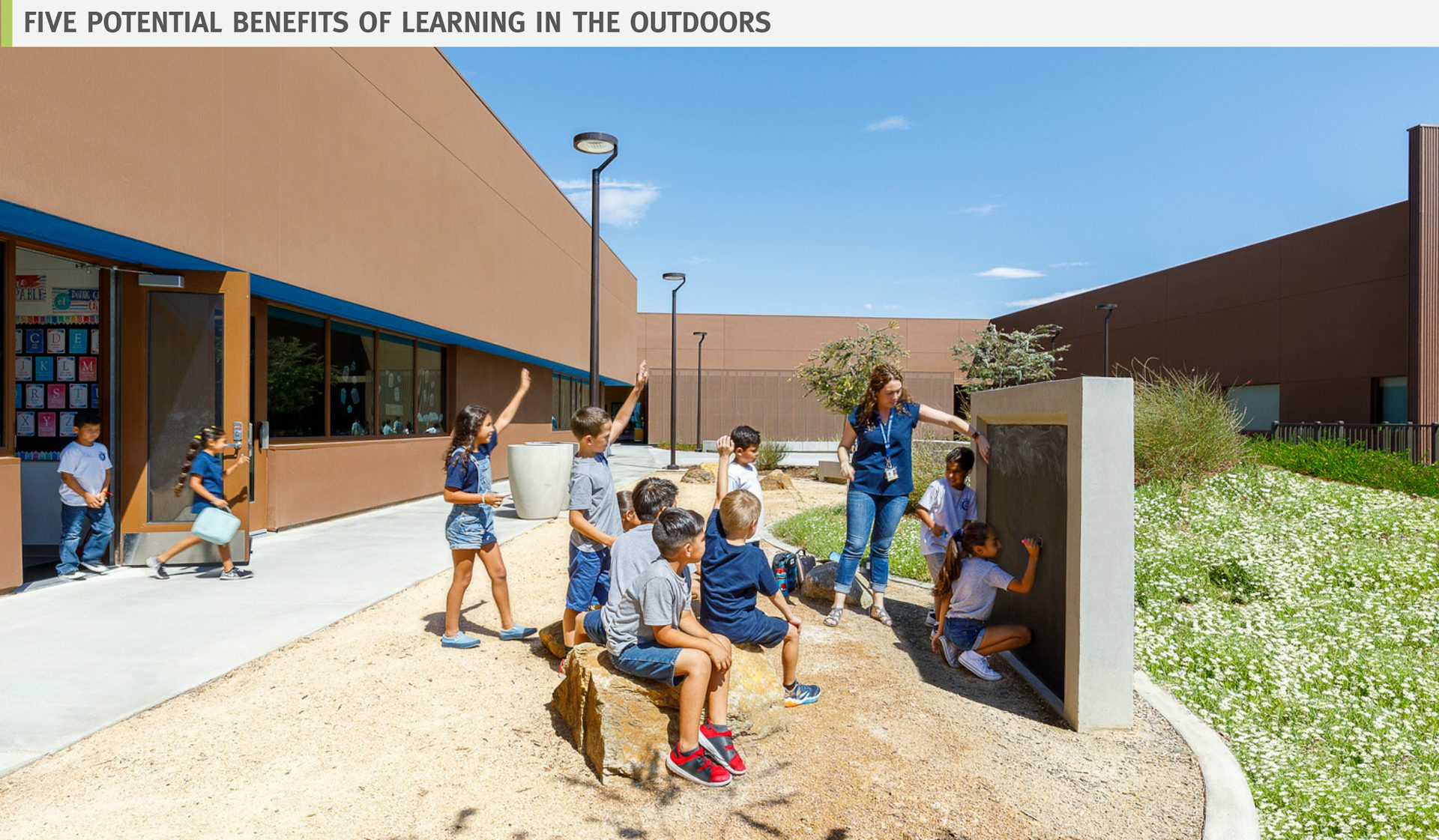
1. Nourish Cognitive Ability
Students spend a large amount of time on focused attention tasks which can lead to cognitive fatigue. Views of the outdoors provides a “soft fascination” for a student’s brain – a brain break – to recover from focused learning. This reduction in stress results in better cognitive capacity.
2. Strengthen Social-Emotional Well-Being
Outdoor learning programs positively impact young people’s interpersonal and social skills including independence, confidence and control. More flexible spatial environments enhance student agency and engagement.
3. Attend to Physical Well-Being
Higher levels of daylight exposure, views of nature and access to the outdoors are linked to a greater sense of well-being, increased alertness and opportunities for physical movement. Outdoor environments can offer a less sedentary learning experience.
4. Develop Eco-Literacy Skills and Pro-Environmental Behavior
Learning outdoors offers the opportunity to develop a deeper relationship with nature—to better understand the seasons, trajectory of the sun, wind patterns, watershed, soil composition, local pollinators and other natural phenomenon.
5. Enhance Core Academic Outcomes
The impact of physical learning spaces on student outcomes is driven by a wide range of features. Factors found to significantly influence a student’s overall progress in core subjects include natural lighting, views overlooking life and better designed and maintained outdoor spaces.

During the redesign of an urban Los Angeles campus, the removal of a large central building provided an opportunity to reimagine the entire layout. The new campus plan organizes and densifies learning spaces to provide students with meaningful outdoor space, says LPA Project Landscape Architect Alan Gonzalez. LPA worked with the district and stakeholders to ensure that planning and design were in alignment with student and community priorities and expectations. The result was a quad that became a nexus for social engagement, performance and interactive learning. It was designed as a ‘park-like’ center and emphasizes connections to nature.
“In urban sites, spaces like these become valuable not only to the students using the space, but also for the larger community as a whole as they tie into the urban fabric,” Gonzalez says. Sustainable strategies are layered into the design and utilized as extensions of classroom learning, including stormwater demonstration gardens, designated planters for food production, native plant selection and preservation of existing mature trees. Signage helps to translate these ideas into students’ minds and educates them about the school’s commitment to sustainability.
For younger learners, in particular, biophilia—the natural attraction humans feel for organic shapes and patterns—can be leveraged to engage learners in different ways. Extensive research demonstrates that biophilic design improves motors skills, social interaction and neurological development, especially in urban areas where greenspace is in short supply.

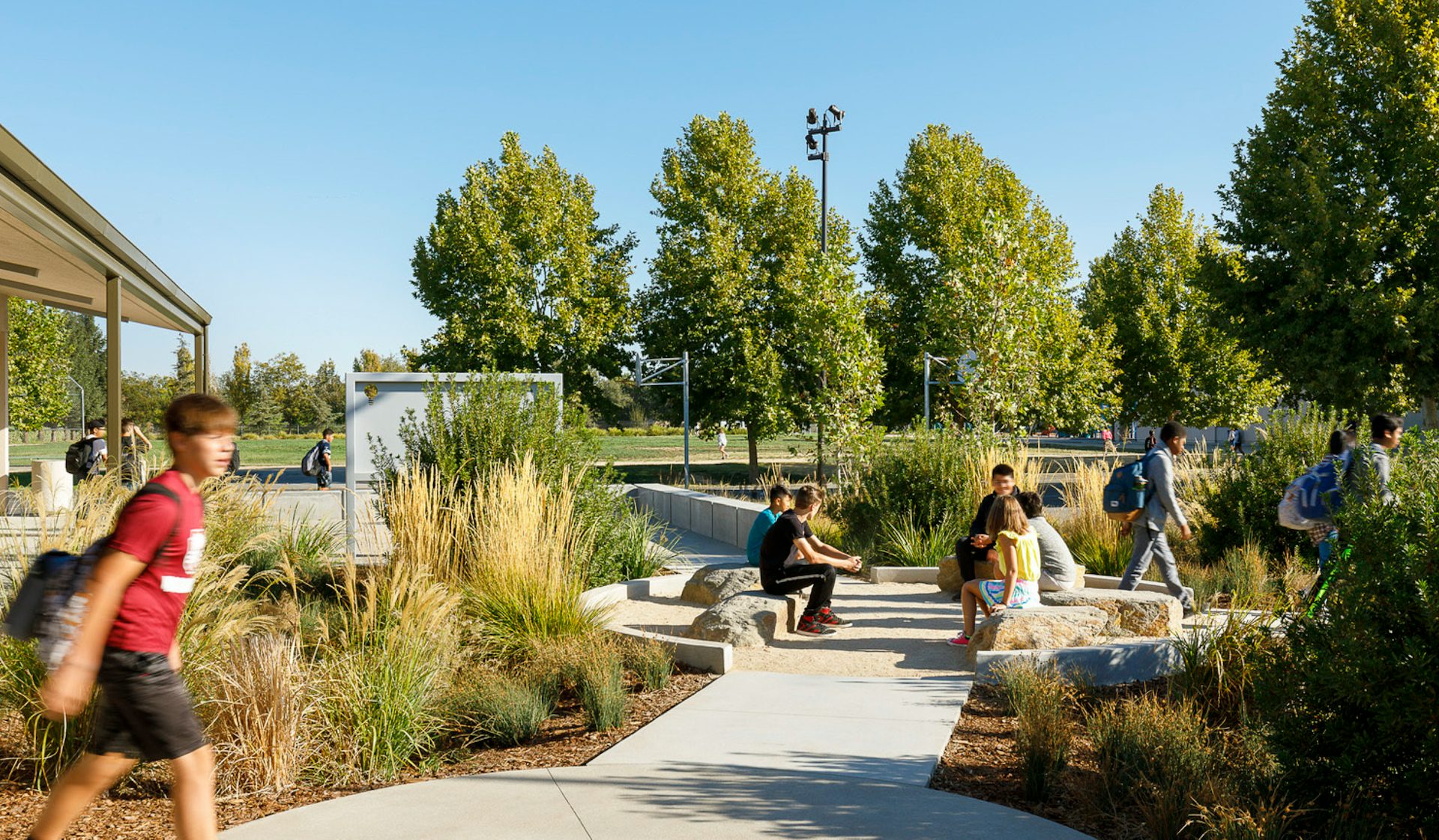
The flat lawns and blacktop surfaces of yesteryear can be replaced with more varied, contoured, naturalistic landscapes boasting native plants. Such changes can provide benefits whether students are indoors or out. From inside the classroom, a student might see and be captivated by the play of sunlight on a row of shrubs or the abstract patterns of plants. Even small changes, such as painting colorful murals on formerly drab walls or replacing asphalt with gravel to provide texture and audio stimulation, can be like “low-hanging fruit” for designers.
For all students, health and wellness are important elements of learning. Bienvenu says that many of the features that college campuses are requesting are becoming popular with high schools. These include fitness zones and spaces that encourage students to spend time outside. Concepts for flexible spaces for outdoor art classes, fire pits and amphitheaters for small performances, are trickling down to high schools and other K-12 buildings.
One challenge in designing these outdoor spaces is figuring out how to balance natural attraction with function, while providing “spaces to unplug and decompress and collect your thoughts,” Bienvenu says.

While everyone sees the urgency in the current situation, schools should be careful about rushing into a COVID-era reworking of their outdoor space, he adds. Scrambling to push activities outside in a hurry can result in hastily developed plans that waste money on quick fixes. The exterior design of educational space needs to be cultivated over time. “A unified, cohesive, long-term vision should be sketched out before trying to rush students outdoors,” Bienvenu says.
Moving forward, the emphasis needs to be on outdoor spaces that support the school’s goal of developing different, critical kinds of learning, Kikuta says. High-performing outdoor learning spaces improve inquisitive and reflective thinking, research shows. Beyond the pandemic, educators and designers always need to be focused on the larger goals, Kikuta says.
“We need to develop empathetic, out-of-the-box risk-takers,” she says. “The problems of tomorrow won’t look like the problems of today.”


